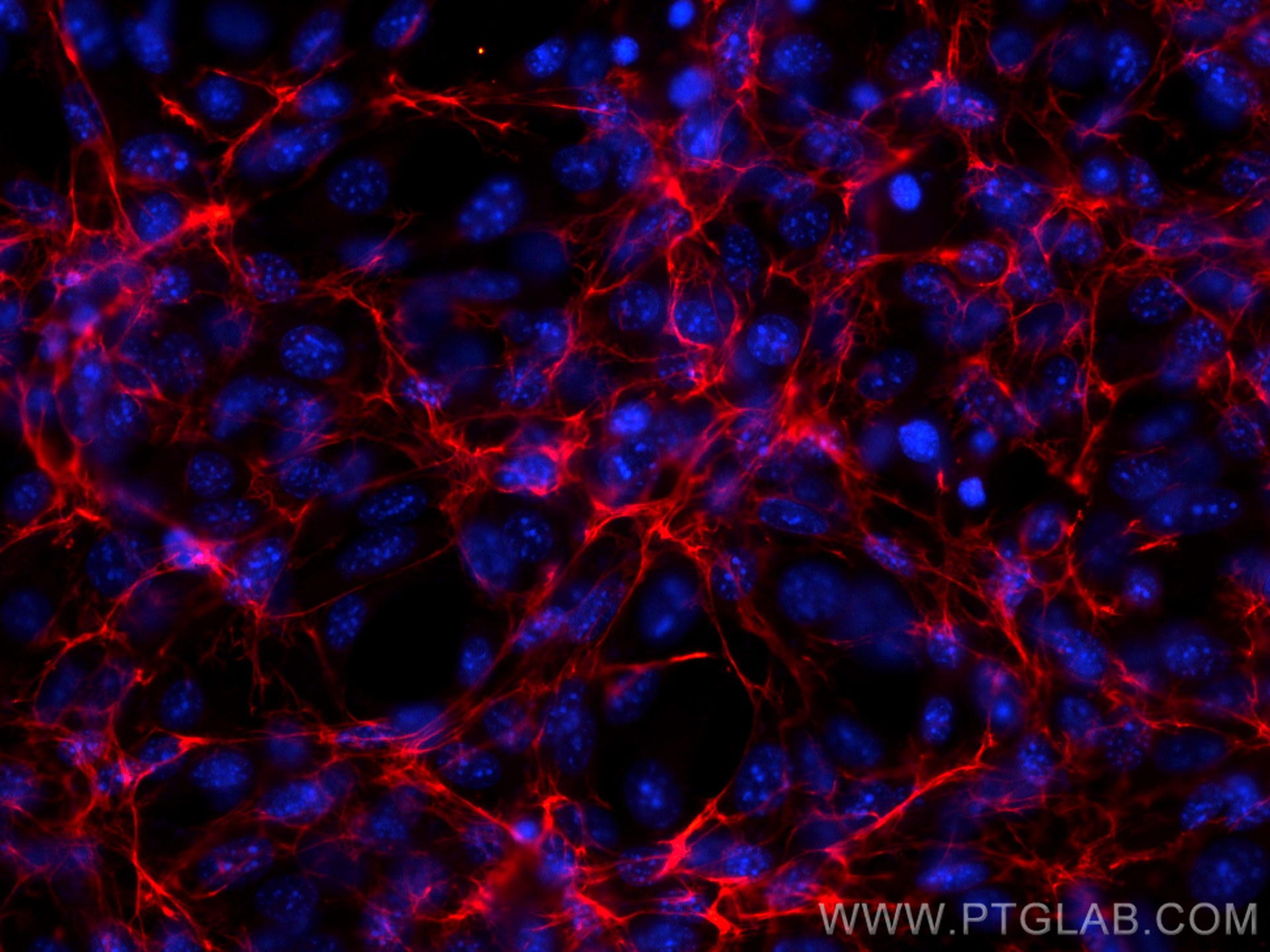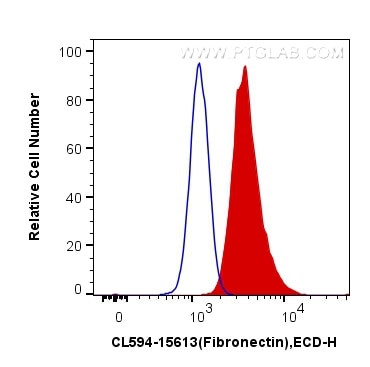Tested Applications
| Positive IF/ICC detected in | NIH/3T3 cells |
| Positive FC (Intra) detected in | NIH/3T3 cells |
Recommended dilution
| Application | Dilution |
|---|---|
| Immunofluorescence (IF)/ICC | IF/ICC : 1:50-1:500 |
| Flow Cytometry (FC) (INTRA) | FC (INTRA) : 0.40 ug per 10^6 cells in a 100 µl suspension |
| It is recommended that this reagent should be titrated in each testing system to obtain optimal results. | |
| Sample-dependent, Check data in validation data gallery. | |
Product Information
CL594-15613 targets Fibronectin in IF/ICC, FC (Intra) applications and shows reactivity with human, mouse samples.
| Tested Reactivity | human, mouse |
| Host / Isotype | Rabbit / IgG |
| Class | Polyclonal |
| Type | Antibody |
| Immunogen |
CatNo: Ag8004 Product name: Recombinant human FN1 protein Source: e coli.-derived, PGEX-4T Tag: GST Domain: 2177-2386 aa of BC005858 Sequence: DQQRHKVREEVVTVGNSVNEGLNQPTDDSCFDPYTVSHYAVGDEWERMSESGFKLLCQCLGFGSGHFRCDSSRWCHDNGVNYKIGEKWDRQGENGQMMSCTCLGNGKGEFKCDPHEATCYDDGKTYHVGEQWQKEYLGAICSCTCFGGQRGWRCDNCRRPGGEPSPEGTTGQSYNQYSQRYHQRTNTNVNCPIECFMPLDVQADREDSRE Predict reactive species |
| Full Name | fibronectin 1 |
| Calculated Molecular Weight | 2386 aa, 263 kDa |
| GenBank Accession Number | BC005858 |
| Gene Symbol | Fibronectin |
| Gene ID (NCBI) | 2335 |
| RRID | AB_2919822 |
| Conjugate | CoraLite®594 Fluorescent Dye |
| Excitation/Emission Maxima Wavelengths | 588 nm / 604 nm |
| Form | Liquid |
| Purification Method | Antigen affinity purification |
| UNIPROT ID | P02751 |
| Storage Buffer | PBS with 50% glycerol, 0.05% Proclin300, 0.5% BSA, pH 7.3. |
| Storage Conditions | Store at -20°C. Avoid exposure to light. Stable for one year after shipment. Aliquoting is unnecessary for -20oC storage. |
Background Information
Fibronectins play a role in cell adhesion, motility, wound healing, and the maintenance of cell shape. Fibronectins bind to cell surfaces via interactions with integrins and various molecules such as collagen, fibrin, heparin, DNA, and actin (PMID: 3326130). Cellular interaction with fibronectin (FN1) promotes cell cycle progression and proliferation by influencing cyclins.
What is the molecular weight of FN1?
The molecular weight of FN1 is 220 kDa.
What is the tissue specificity of FN1?
FN1 is a large glycoprotein that exists in both a soluble form in plasma (plasma FN1) and other body fluids and an insoluble form in the extracellular matrix (cellular FN1) (PMID: 21923916). Plasma FN1, or the dimeric form, is secreted by hepatocytes, whereas cellular FN1, the dimeric or cross-linked multimeric form, is produced by fibroblasts and epithelial cells and deposited as fibrils in the extracellular matrix.
What are the post-translational modifications of FN1?
FN1 is often sulfated and its C-terminal NC1 peptide, anastellin, is produced as a result of proteolytic processing and can inhibit tumor growth, angiogenesis, and metastasis by activating p38 MAPK and inhibiting lysophospholipid signaling (PMID: 11209058).
What is FN1's role in embryogenesis?
Fibronectin has a crucial role in the development of the left-right body axis during embryogenesis (PMID: 21466802).
What is FN1's involvement in disease?
Fibronectin glomerulopathy is a kidney disease that eventually leads to end-stage renal disease and is caused by mutations in the FN1 gene. Mutations in FN1 lead to the production of abnormal fibronectin protein that is deposited in the glomeruli of the kidney (PMID: 18268355).
Protocols
| Product Specific Protocols | |
|---|---|
| FC protocol for CL594 Fibronectin antibody CL594-15613 | Download protocol |
| IF protocol for CL594 Fibronectin antibody CL594-15613 | Download protocol |
| Standard Protocols | |
|---|---|
| Click here to view our Standard Protocols |






